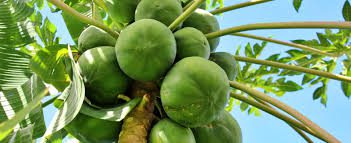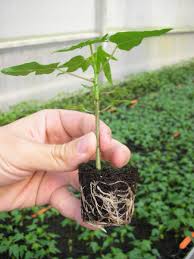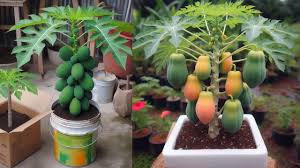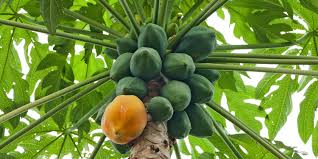Pawpaw fruit growing conditions are essential to understand for anyone interested in cultivating this unique and nutritious fruit. The pawpaw, known scientifically as Asimina triloba, is the largest edible fruit native to North America and offers a tropical flavor profile that is often described as a mix between banana, mango, and melon.
Understanding the specific requirements for growing pawpaw is crucial for successful cultivation and fruit production. Pawpaw trees thrive in USDA hardiness zones 5 to 8, making them suitable for a variety of climates across the United States.
These trees prefer well-drained, loamy soil rich in organic matter, as this type of soil retains moisture while allowing excess water to escape. It’s important to test the soil pH, which should ideally range from 5.5 to 7.0 for optimal growth. Poorly drained or compacted soils can lead to root rot and other issues that inhibit healthy growth.
Amending the soil with compost or well-rotted manure can significantly enhance soil structure and fertility, providing the necessary nutrients for young trees.
Light exposure is another critical factor in pawpaw fruit growing conditions. While pawpaw trees can tolerate partial shade, they perform best in full sun to partial shade. A location that receives at least six hours of direct sunlight daily will encourage vigorous growth and enhance fruit production.
However, it’s important to note that young saplings may benefit from some protection from intense afternoon sun, especially in hotter climates, to prevent leaf scorch.
Watering is also vital in the early stages of pawpaw growth. Pawpaw trees require consistent moisture, particularly during dry spells. Deep watering is recommended to encourage deep root development. Once established, pawpaw trees are relatively drought-tolerant, but maintaining consistent moisture during the growing season will lead to healthier trees and more abundant fruit yields.
Temperature plays a significant role in pawpaw cultivation. These trees require a period of winter chill to break dormancy, making them unsuitable for tropical climates without a distinct winter.
However, they can tolerate short periods of frost. Young trees are especially sensitive to cold, so providing a layer of mulch around the base can help protect the roots during colder months. Additionally, planting pawpaw trees in sheltered locations can provide some protection from harsh winter winds and extreme temperatures.
Pawpaw trees are also sensitive to pests and diseases, which can affect their growth and fruit production. Common pests include pawpaw peduncle borers and various leaf-eating insects, while diseases such as pawpaw anthracnose can hinder growth if not managed properly. Implementing integrated pest management strategies, such as encouraging beneficial insects and proper sanitation, can help mitigate these issues.
Ideal Climate for Pawpaw Growth
1. Temperate Climate: Pawpaw trees thrive in temperate climates, with temperatures ranging from 75°F to 85°F (24°C to 29°C) during the growing season.
2. Cold Hardiness: They can tolerate winter temperatures as low as -10°F (-23°C) but prefer milder conditions to ensure proper fruit development.
3. Humidity Levels: Moderate humidity is beneficial, as pawpaw trees prefer a humid environment that mimics their native woodland habitats, helping to reduce stress on the trees.
4. Rainfall Requirements: Pawpaw trees require about 30-40 inches (76-102 cm) of rainfall annually, which should be evenly distributed throughout the year to support healthy growth.
5. Protection from Frost: Young pawpaw trees are susceptible to frost damage, so planting in frost-free areas or using protective measures can enhance their survival and fruiting potential.
Soil Requirements for Pawpaw Cultivation
1. Well-Drained Soil: Pawpaw trees prefer well-drained, loamy soil that prevents waterlogging, which can lead to root rot and other diseases.
2. Soil pH: An ideal soil pH for pawpaw cultivation ranges from 5.5 to 7.0, as slightly acidic to neutral soils promote optimal nutrient uptake.
3. Organic Matter Content: Incorporating organic matter, such as compost, improves soil fertility and structure, enhancing moisture retention and nutrient availability for pawpaw trees.
4. Nutrient-Rich Soil: Soils rich in essential nutrients like nitrogen, phosphorus, and potassium support healthy growth and fruit development, so regular soil testing is recommended.
5. Avoiding Heavy Clay: Heavy clay soils can impede drainage, so it’s essential to amend these soils with organic matter or plant pawpaw in raised beds to improve drainage conditions.
Sunlight and Shade Needs for Pawpaw Trees

1. Full Sun Requirement: Pawpaw trees thrive in full sun conditions, requiring at least 6-8 hours of direct sunlight daily for optimal growth and fruit production.
2. Light Competition: While young trees can tolerate some shade, pawpaw trees will perform best in areas where they are not shaded by larger trees or structures, as competition for light can hinder their growth.
3. Dappled Shade Tolerance: Mature pawpaw trees can tolerate some dappled shade, making them suitable for planting under taller trees, especially in their early growth stages.
4. Sunlight Exposure in Fruit Development: Adequate sunlight is crucial during fruit development, as insufficient light can lead to smaller, less flavorful fruits.
5. Sun Protection for Young Trees: Newly planted pawpaw trees may benefit from temporary shading during extreme heat or intense sunlight to reduce transplant shock and stress.
Watering Guidelines for Pawpaw Plants
1. Consistent Moisture: Pawpaw plants require consistent moisture, especially during the first year after planting, to establish a strong root system.
2. Soil Drainage: Ensure that the soil is well-drained; overwatering can lead to root rot, so water only when the top inch of soil feels dry.
3. Deep Watering: Water deeply to encourage roots to grow down into the soil; aim for about 1-2 inches of water per week, adjusting for rainfall.
4. Mulching: Apply a layer of organic mulch around the base of the tree to help retain soil moisture, regulate temperature, and suppress weeds.
5. Watering During Fruit Development: Increase watering frequency during fruit development stages, as pawpaw trees require more moisture to support fruit size and quality.
Fertilization Practices for Healthy Pawpaw Trees
1. Soil Testing: Conduct soil tests to determine nutrient levels and pH before fertilizing; this helps in tailoring the fertilizer application to specific needs.
2. Balanced Fertilizers: Use a balanced fertilizer (e.g., 10-10-10) in early spring, applying about 1 pound (0.45 kg) per year of tree age, up to a maximum of 5 pounds (2.27 kg) for mature trees.
3. Organic Options: Consider organic fertilizers, such as compost or well-rotted manure, which provide nutrients while improving soil health.
4. Post-Fruiting Fertilization: After harvesting, apply additional fertilizers to replenish nutrients, especially potassium and phosphorus, which are crucial for tree health.
5. Avoid Over-Fertilization: Be cautious with fertilizer application; excessive nutrients can harm the tree and result in poor fruit quality or promote excessive foliage growth over fruit production.
Pest and Disease Management in Pawpaw Cultivation
1. Regular Monitoring: Regularly inspect pawpaw plants for signs of pests (e.g., aphids, spider mites) and diseases (e.g., anthracnose, crown rot) to catch issues early.
2. Cultural Practices: Implement good cultural practices, such as proper spacing and pruning, to improve air circulation and reduce humidity around the plants, minimizing disease risk.
3. Organic Pest Control: Use organic pest control methods, such as insecticidal soap or neem oil, to manage pest infestations without harming beneficial insects.
4. Disease-Resistant Varieties: Choose disease-resistant pawpaw varieties whenever possible, as these are more likely to thrive with fewer inputs.
5. Crop Rotation: Consider rotating pawpaw with other crops to disrupt pest and disease cycles, reducing their impact on pawpaw cultivation.
Read Also: 7 Medicinal Health Benefits of Daffodils (Narcissus Plant)
Propagation Methods for Pawpaw Plants

1. Seed Propagation: The most common method is seed propagation; collect seeds from ripe fruits, clean them, and plant them in well-drained soil, keeping them moist until germination.
2. Stratification Process: For better germination rates, stratify seeds by placing them in a damp medium in the refrigerator for 30-60 days before planting.
3. Grafting and Budding: Grafting or budding can be used to propagate specific varieties or to combine desirable traits from different plants for improved quality and yield.
4. Root Suckers: Pawpaw trees produce root suckers; these can be dug up and transplanted to create new plants, ensuring they have roots for establishment.
5. Tissue Culture: For advanced growers, tissue culture can be used to propagate pawpaw plants, ensuring disease-free, genetically identical plants for commercial production.
Pruning Techniques for Optimal Growth
1. Timing: Prune pawpaw trees in late winter or early spring before new growth begins, allowing the tree to recover quickly without stressing it.
2. Remove Dead or Damaged Wood: Cut away any dead, damaged, or diseased branches to improve air circulation and reduce the risk of disease, promoting overall tree health.
3. Thin Out Crowded Branches: Thin out crowded branches to allow sunlight to penetrate the canopy, which helps improve fruit quality and reduce the risk of pest infestations.
4. Maintain an Open Center: Encourage an open center growth habit by removing inner branches; this allows for better airflow and light penetration, crucial for fruit development.
5. Shape the Tree: Shape the tree by selectively shortening long branches, maintaining a balanced structure that can support fruit load without breaking under weight.
Read Also: Pests of Stored Products and Damages Caused
Harvesting Tips for Pawpaw Fruit

1. Ripeness Indicators: Harvest pawpaw fruits when they turn a yellow-green color and begin to soften slightly; ripe fruits should yield gently to pressure.
2. Gentle Handling: Handle the fruits carefully to avoid bruising, as pawpaw fruits are delicate; use gloves to protect your hands and the fruit from damage.
3. Harvesting Tools: Use clean, sharp pruning shears to cut the stem of the fruit, ensuring a clean cut to prevent damage to both the fruit and the tree.
4. Timing of Harvest: Harvest in the morning or late afternoon when temperatures are cooler, as this helps maintain fruit quality and minimizes stress on the tree.
5. Harvesting Frequency: Regularly check the trees during the harvest season and pick ripe fruits every few days to ensure peak freshness and flavor.
Post-Harvest Care for Pawpaw Fruits
1. Cleaning Fruits: Gently clean harvested pawpaw fruits with a damp cloth to remove dirt and debris without bruising the skin, preparing them for storage or sale.
2. Optimal Storage Conditions: Store ripe pawpaw fruits at room temperature for a few days to allow them to fully ripen; if overripe, refrigerate to extend shelf life.
3. Handling and Packing: Pack pawpaw fruits in shallow containers lined with soft materials to prevent bruising and damage during transportation.
4. Monitoring for Spoilage: Regularly check stored fruits for spoilage, as pawpaw can be sensitive to temperature changes; remove any spoiled fruits immediately to prevent affecting others.
5. Processing Options: Consider processing excess fruits into purées, jams, or desserts if not consumed fresh; this can reduce waste and add value to pawpaw harvests.
Do you have any questions, suggestions, or contributions? If so, please feel free to use the comment box below to share your thoughts. We also encourage you to kindly share this information with others who might benefit from it. Since we can’t reach everyone at once, we truly appreciate your help in spreading the word. Thank you so much for your support and for sharing!
Read Also: Relationship Marketing Process and Approaches to the Study of Marketing
Frequently Asked Questions
We will update this section soon.

